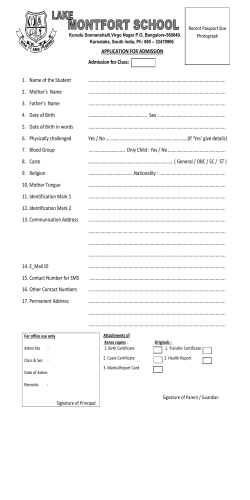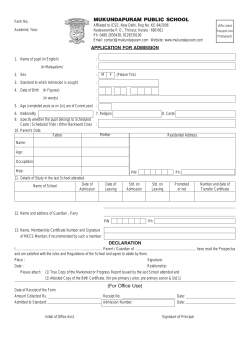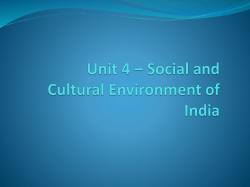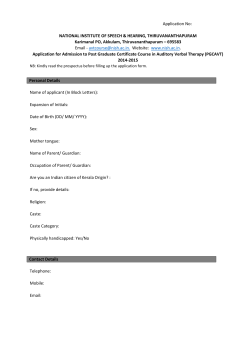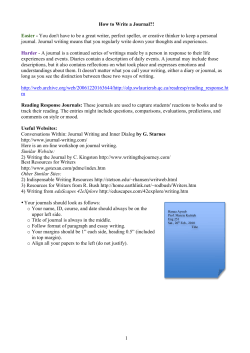
PDF - The Criterion
About Us: http://www.the-criterion.com/about/ Archive: http://www.the-criterion.com/archive/ Contact Us: http://www.the-criterion.com/contact/ Editorial Board: http://www.the-criterion.com/editorial-board/ Submission: http://www.the-criterion.com/submission/ FAQ: http://www.the-criterion.com/fa/ www.the-criterion.com The Criterion: An International Journal in English ISSN: 0976-8165 Dalit Literature: Writings of Revolt and Assertion Haroon Rasheed (Kmc,Uaf University), Lucknow, Up I'm now the sea; I soar, I surge, I move out to build your tombs. The winds, storms, sky, earth, Now all are mine. In every inch of the rising struggle, I stand erect. (J.V Pawar" I have Become the Tide") The above lines by J.V Pawar echo the rebellious outburst of an oppressed soul. There is a projection of the feeling of resentment and a desire for equality which form the most integral part of Dalit writings. The new Dalit writing is ready to demolish the unequal and unjust social order and it is replacing the humble urge for acceptance found in early Dailt literature with an angry assertion.Sharan Kumar Limbale writes that 'rejection' and 'revolt' in Dalit literature have been birthed from the womb of Dalits' pain. They are directed against an inhuman system that was imposed on them. Just as the anguish expressed in Dalitliterature is in the nature of a collective social voice, similarly the rejection and revolt are social and collective. During an interview to The Hindu, Limbale expresses his views about Dalitliterature, "It expresses the pain and pangs of the Dalitexistence ; it is the lived reality of crores of people living on the margins of the life in India; it verbalizes the suppressed anger and wounded pride of those existing outside the caste identities" Though the caste system in India was officially abolished over fifty years ago, the discrimination is still surviving not only in villages but also in big towns. Dalits are often forbidden from using same religious temples, living in same areas and marrying into the families of the country's upper castes. To unfold all these problems to the society,Dalitliterature has come into existence. It protests against all forms of exploitationbased on class, race, caste or occupation. It had not been recognized as a literature till 1970 but now its name is being heard all around the world. It has made the people think against the exploitation and suppression. The rise of this literature marks a new chapter for India's marginalized class. Preaching to the Dalits Baba Sahebsaid that one should throw away the sense of inferiority from one's mind. The roots of inferiority complex in them lay in their acceptances of themselves as a part of the Hindu religion where the master has a storehouse of rights but no duties. His surrender to such a religion had made him a slave. In such a situation in order to abolish their slavery, the untouchables will have to come to the front themselves. They need to stand on their feet themselves. The varnasystem was the root of all inequalities. This is the mother of casteism and untouchability which is another form of inequality. It was this varnasystem which denied education even to those who had competence. Continuous struggle is required to get back the rights that were lost. With the awakening of people's consciousness against injustice, the path to struggle would automatically open. Dalits produced literature even before religious conversion but there was a difference: the objective of literature before the conversion seem to have changed after the conversion. Because of the impact of the Ambedkarian thought,aturmoil took place in the traditional literature.Silenced for centuries by caste prejudice and social oppression, the Vol. 5, Issue. VI 087 December 2014 www.the-criterion.com The Criterion: An International Journal in English ISSN: 0976-8165 Dalitsof Maharashtra registered their protest in the form of short stories, poetry, novels and autobiographies. The volatile surroundings made writers like AnnabhauSathe (1920-1969) depict through realistic and effective writing the inhumanity, lawlessness and cruelty. He wrote thirty five novels, one among them was Fakira (1959). Sathe wrote directly from his experiences in life, and his novels celebrate the fighting spirit in their characters who work against all odds in life. Dalit literature emerged into prominence and as a collective voice after 1960 a fresh crop of new writers like BaburaoBagul, BandhuMadhav and ShankaraoKharat, came into being with the Little Magazine Movement. They represent a new, direct, angry, accusatory, and analytic voice in the literature. BaburaoRamchandraBagul (1930-2008) the Father of Dalit literature touched people’s mind through his revolutionary literature. As an architect of Dalit literature he has made a valuable contribution to Indian literature. BaburaoBagul was the main exponent of Dalit (low caste) literature in Maharashtra. Bagul’s writings started an era of revolutionary writing in Marathi literature. His writings were influenced by the writers like Marx, Lenin, Gorki and Chekov Apart from these writers he was influenced by the thoughts and writings of Gautam Buddha, Mahatma Phule and Ambedkar. The extreme poverty, misery and oppression that he experienced in his childhood are evident in his works. His collection of short stories Jevah Mi JaatçhorliHoti (When I robbed a caste) — 1963 MaranSwast Hot Aahe-1969 (Death is becoming cheap) broke all norms of conventional story writing in Marathi and altered the face of short- story writing.Sood (Revenge) — 1970 and two novels Aghori— 1980 and Kondi — 2000 are depiction of the miseries, frustrations and struggles of the downtrodden. He was the first writer who associated Dalit literature with African American literature and initiated the internationalisation of Dailt literature.Dalit writer NamdeoDhasal has compared him with Russian writer Dostoyevsky whose realistic portrayal of the common man in his stories and novels was akin to the same humane approach that came through in Bagul’s writings.In the words of M. N. Wankhede he was the Dalitangry young man, considering the revolutionary culture that he imbibed into Marathi literature and his image in literature and contemplation. Bagul said that although he inherited his caste by virtue of his birth, at the time of writing he felt one with all the downtrodden of the world. The sixties saw Bagul’s name synonymous with Marathi Dalit literature. His writings were par excellence in comparison with other Dalitliterateurs. ArunKamble, ShantabaiKamble, KrushnaKamble, Raja Dhale, NamdevDhasal, BandhuMadhav, Laxman Mane, LaxmanGaikwad, HariNarake, SharankumarLimbale, WamanNibalkar, BhimsenDethe and BhauPanchbhai all these people in their own ways, capacities and capabilities advanced the work that Dr. BabasahebAmbedkar started. NamdeoDhasal,Kamble and Raja Dhale formed Dalit Panther a social organization. NamdeoDhasal’s works express the anguish and aspirations of Dalits in India: the sense of having been the exploited and condemned builders of Indian civilization and the inherent, suppressed urge to emerge out of centuries of darkness and suffering to claim their just heritage and space in society. The disapproval and rebellious style of his poems show his extreme hatred for the system. It is apparent that the persistent output of Dalitliterature by its representation of the lives of the most marginalized shook the main- stream literary tradition to its core. Great poets like Narayan Survey, NamdeoDhasal, DayaPawar, Sharan Kumar Limbale, Arjun Dangle, and many other poets wrote stunningly new Indian poetry in the sixties and seventies. Many were inspired by their liberated spirit, straight and strong style, and poignant poetic images. They portrayed the life and struggles of the lowest strata, the low caste. The Dalit litterateurs think that so long as the discriminative caste system exists there can neverbe complete freedom, brotherly feeling and justice established in the nation. The following lines by DayaPawar depict the anger and burning desire for revenge among the writers Vol. 5, Issue. VI 088 December 2014 www.the-criterion.com The Criterion: An International Journal in English ISSN: 0976-8165 That some were high while others were low? Well, all right, then this city deserved burying— Why did they call it the machine age? Seems like the Stone Age in the twentieth century. Dalit literature enforces the people to protest in non-violence, not to revolt with violence. The writers of this literature have pondered about their problems not only in poetry but also in fictional works. Omprakash and KeshavMeshram are the finest examples for it. His Joothan, first published in Hindi in 1997 and translated into English by ArunPrabhaMukherjee in 2003, is an autobiographical novel which explainsDalit life in north India from an insider’s perspective. Joothan deals with Dalit history and revolutionary changes in the society. Joothan literally means scraps of food left on a plate, destined for the garbage or for the family pet in a middle-class urban home. It is related to the word joothanwhich means polluted and such scraps are characterized as joothanonly if someone else eats them. The novel pushes the people into a deep thinking towards thejoothanand it tells Dalit that it is not good to depend on joothan.Humiliated people are humiliated again and again so it tries to say that not to be humiliated. Though many well known people like Ambedkar and Gandhi advised untouchables to stop acceptingjoothan it is notyet ended. Valmiki thinks that the Dalit literature can bring the changes in the society. His community looked forward to marriage feasts in the village when they would gather outside with big baskets. After the guests had eaten, the dirty pattals, or leaf platesare put in the Chuhras’ baskets, which they took home, to save the joothansticking to them. The power of Dalit autobiography’s narrative agenda is its use of the author’s life – experience of pain as a means of political assertion. By writing about their own experience as a Dalit, OmprakashValmiki and SurajpalChauhan reveal two objectives in their autobiographies. One is to contest the basis of caste discrimination. For example, in Joothan,Valmiki asserts: Being born is not in the control of a person. If it were in one’s control, then why would I have been born in a Bhangi household? These who call themselves the standard- bearers of this country’s great culture heritage, did they decide which homes they would be born in to?Albeit they turn to scriptures to justify their position, the scriptures that establish feudal values instead of promoting equality and freedom. (Valmiki 133-4) Besides the male writers, Dalit women writers and writings came into existence. The women are claimed by both Dalit and feminist movements across India. The women have to overcome the three problems like race, class and gender. They use various literary strategies to reject the role of victim in these three aspects. Their writings are focused on rape, torture and suppression by male psyche. The quest for identity is the main theme in most of the novels. Adopting a Dalit feminist standpoint means " sometimes losing, sometimes envisioning the 'voice' that I had as unmarked feminists" (SharmilaRege, 2006:387-88). The literature of the feminists suggests the possibility of a shift from a male centered Dalit consciousness to the development of a more-feminist politics. Baby Kamble'sThePrisons We Broke is the first work that comes in Dalit literature which is written by a woman. It is because of that itself, the book deals with the two major problems of the society: firstly, the oppression and exploitation of the Dalit by the upper class: secondly the discrimination towards women in a patriarchal society.Bama'sKarukku, the first Dalit autobiographical novel, acquired a specific identity, and focused on the problems of Dalit women. Though Bama is a Christian woman, she pointed out the problems of low caste women. The women are compelled to voice their misery doubled up due to caste and gender discrimination. The result is the rise of Dalit Feminism. As an exponent of the feminism, Bama has found in Vol. 5, Issue. VI 089 December 2014 www.the-criterion.com The Criterion: An International Journal in English ISSN: 0976-8165 Karukku the right space to articulate the travails and sufferings of Dalit women.ofDalit women. The main intention of the writer is to bring out what is going on around India in the lives of Dalit. The novel comes across as a sincere attemptto tell a story that is matter-offactly indignant about ill-treatment in the name of class, caste and religion. The famous line by her in the novel is that a Dalit woman is a Dalit amongst the Dalits. She is three times oppressed by her caste, race and gender. In Bama’s case her position is further endangered by her existence as a Dalit Christian. Hence Karukkufocuses on three essential forces that cuts across and sears Bama’s life, namely: caste, gender and religion. Bama gives us a clearpicture of the caste oppression meted out to the Christians not only by the upper caste society but more so within the catholic church itself. Bama has always had an inner urge to actively engage herself in alleviating the sufferings of the oppressed. The book is about Bama’s inner quest for self-discovery and the resultant courage, which forces her to move away from the life ofa nun to live the life ofa Dalit woman. Bama’s second novel Sangati reveals the inexplicable and unarticulated bond that strengthens the spirit of the Dalit women. In the midst of all the misery there is an inseparable liveliness in the lives of women. They would always laugh and chatter “even though they left at dawn and hardly ever came back until after dark, they still about laughing and making a noise for the greater part.” (Bama 2005: 76) Finally, I conclude that Dalit literature deals with not only the themes of marginality and resistance but also it explains about the Marxist changes. It is a living, breathing literary movement that is intent on establishing itself as an integral part of the field of Indian literature. The other important thing is that Dalit writers should establish their mark in world literature bywritingthe marginal stories inEnglish. The literature is the light mark for world-shattering changes and it becomes a cathartic strife for purgation ofdefiled social system. It will eradicate the problem ofuntouchables and brings the idea of social, economic and political equality in the society. Dalit writings have conveyed about a change in the attitude of low caste people. It has placed them on the tracks of self – realization and equality. It has also instilled amongst them a confidence and pride about their existence. Works Cited: Bama .Karukku .Trans .LakshmiHolmstrom .Chennai : Macmillan India, 2000. Print. Bama .Sangati .Trans .LakshmiHolmstrom . New Delhi : Oxford University Press, 2005. Print. Dangle,Arjun . ed .Poisoned Bread. New Delhi : Orient Blackswan, 2009. Print. Limbale, Sharankumar .Towards an Aesthetic of Dalit Literature. Trans. AlokMukherjee. New Delhi : Orient Longman, 2004. Print. Natarajan, Nalini .ed.AHandbook of Twentieth Century Literatures of India. Westport, C.T. : Greenwood Press, 1996. Print. Valmiki, Omprakash. Joothan.Trans. ArunPrabhaMukherjee. London: Columbia U P, 2003. Print. Vol. 5, Issue. VI 090 December 2014
© Copyright 2025










